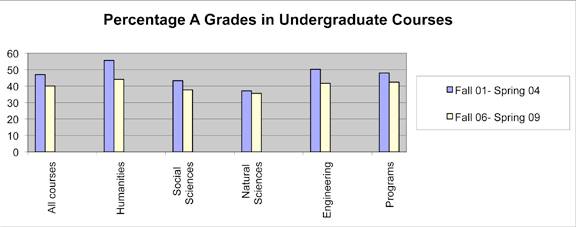Following the Monday, Sept. 21, faculty meeting, Dean of the College Nancy Malkiel issued the following statement on behalf of the Faculty Committee on Grading regarding grading results for 2008-09:
The Faculty Committee on Grading today announced that the Princeton faculty last year reached a major milestone in the implementation of the University's new grading policy, with 39.7 percent A grades in undergraduate courses, down from a high of 47.9 percent before the grading policy was adopted. While Princeton grades have been coming down steadily since the policy was approved by a vote of the faculty in April 2004, 2008-09 is the first year that the percentage of A grades fell below 40. These results confirm once again that with clear intent and concerted effort, a university faculty can bring down the inflated grades that -- left uncontrolled -- devalue the educational achievements of American college students. The Princeton faculty continues to make successful progress in its determined effort to restore educational content and meaning to the letter grades earned by the highest-achieving students in the United States.
Princeton's new grading expectations, adopted by the faculty in April 2004, posit a common grading standard for every academic department and program, under which A's (A+, A, A-) shall account for less than 35 percent of the grades given in undergraduate courses and less than 55 percent of the grades given in junior and senior independent work. The standard by which the grading record of a department or program will be evaluated is the percentage of A's given over the previous three years.
Progress has varied by division, with the social sciences and natural sciences essentially holding steady for the last four years (during that period, A grades in the social sciences have ranged from 37.1 to 37.9 percent, and in the natural sciences, from 35.1 to 35.9 percent). In the humanities and engineering, the divisions that have been slower to make progress, 2008-09 brought significant gains, with a two-point decrease in the percentage of A grades in each division in comparison with 2007-08 (42.5 percent A grades in the humanities in 2008-09, 40.6 percent in engineering).
The chart below compares the percentage of A grades in 2006-09, the most recent three-year period under the new grading policy, with 2001-04, the three years before the faculty adopted the policy.

The committee noted the remarkable success of many departments both in bringing their grades down and in maintaining their gains. But it observed also that there continues to be more variation among departments than the policy anticipates. The committee will be working closely with departments that are still having some difficulty in controlling their grades to devise specific strategies for turning these situations around.
The Grading Committee once again reiterated its confidence in the educational benefits of the faculty's successful effort to bring grades under better control. The committee also reaffirmed its previous findings that the success of Princeton students in the job market and in admission to graduate and professional schools remains largely unchanged since the implementation of the new grading policy. Detailed data about employment and admissions will be included in the third edition of the pamphlet, Grading at Princeton: Frequently Asked Questions, which will be distributed later this month to all faculty, undergraduates, and undergraduate parents.
The Faculty Committee on Grading consists of six elected faculty members: Scott Burnham, music; Daniel Marlow, physics; Helen Milner, politics; Jennifer Rexford, computer science; Mark Rose, molecular biology; and Alexander Smits, mechanical and aerospace engineering. The dean of the faculty, the dean of the college and the registrar serve ex officio. The committee's charge from the faculty is to assess the progress made in implementing the new grading expectations and to offer advice on ways of making further progress.